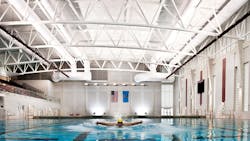Dehumidifiers Help Prevent IAQ Problems in World-Class Aquatic Center
Completed in April 2011, Jenks (Okla.) Public Schools’ Jenks Trojan Aquatic Center (JTAC) consists of two swimming facilities: the new Olympic-sized Competition Pool and the renovated Jenks High School pool, now known as the Instructional Pool.
The highlight of the 50,000-sq-ft, $19 million JTAC is the world-class Competition Pool, site of the Speedo Champions Series Central Zone Senior Sectionals in March 2012. Similar major swim meets across the country have been marred by poor breathing conditions brought on by the buildup of chloramines, but the event at the JTAC, which drew 626 swimmers, 80 coaches, 60 volunteers, 30 referees, and more than 1,000 spectators, garnered rave reviews for its indoor-air quality (IAQ).
“The IAQ was the best I’ve ever seen at a major swimming competition,” George Villarreal, JTAC manager and 20-year swimming-industry veteran, said. “There were no signs of coughing, burning eyes, and the environment was comfortable for swimmers and spectators alike.”
In a USA Swimming survey of 100 participants, the JTAC received a rating of 3.9 on a scale of 1 to 4 for IAQ. It was by far the highest IAQ rating of the previous 10 major meets held in the seven-state region.
The JTAC’s high marks for IAQ are credited to the specification of two custom-manufactured 64-ton NE Series dehumidifiers from Seresco Technologies Inc. combined with one of the first applications of the Evacuator chloramines source-capture/exhaust system from Paddock Pool Equipment Company Inc.
The Seresco units heat or cool the space to 82°F and dehumidify it to 55-percent relative humidity. Their heat-recovery capability offers the opportunity to integrate free 80°F pool-water heating in the future. Each 46,500-cfm unit recovers compressor heat for pool-water heating and uses energy-saving direct-drive plenum fans with variable-frequency-drive control. On days when outdoor conditions are ideal, the system shifts into economizer mode for additional energy savings.
System operation is streamlined with Seresco’s WebSentry remote monitoring/control service. WebSentry allows Seresco factory technicians or local service technicians to monitor and control more than 100 operating parameters around the clock. In the event of a performance issue, authorized JTAC employees are notified via e-mail.
Reducing Chloramines
Even when ventilation, temperature, and relative humidity in a natatorium are ideal, chlorine molecules attach to ammonia and other organics introduced by swimmers, resulting in a heavy, noxious gas at the water’s surface. Typical natatorium ventilation designs direct supply air toward the perimeter and down to breathing zones at the deck surface, with very little of the air reaching the pool surface. Evacuator, a plenum-type device integrated into one width of the pool gutter system, draws chloramines directly off of the pool surface.
Evacuator is ducted to fans in the Seresco units, which carefully monitor and control building pressurization. This significantly reduced equipment costs.
Evacuator is positioned at the pool edge nearest the return-air grille, which helps to draw chloramines toward the evacuation system.
Helping to extend the facility’s life are materials able to withstand the harsh environments of natatoriums. For example, the entire pool is tiled, instead of plastered, while corrosion-resistant porcelain covers many square feet of wall surface.
The dehumidifiers condition the 1,200-seat spectator section for typical daily use. In the event of a heavily attended swim meet, a makeup-air package unit from AAON provides backup.
The main pool area has four runs of 54-in.-diameter Sedona-Xm antimicrobial-treated permeable fabric duct, each with two devices for adjusting air distribution, from DuctSox Corp. Linear vents span the entire length and ensure even and gentle air distribution. Factory-engineered Comfort-Flow air-dispersion porosity allows a small amount of air to flow through the fabric to eliminate dust buildup and condensation. The spectator area uses 42-in.-diameter duct from its dedicated HVAC system.
For Design Solutions author guidelines, call Scott Arnold, executive editor, at 216-931-9980, or write to him at [email protected].
